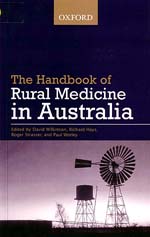 | The Handbook of Rural Medicine in Australia Oxford University Press, Oxford, 2004 |
The editors of this handbook all have international reputations in the field of rural medicine, and are supported by contributors with high levels of experience in their chosen field.
The book has a clear layout, in which shading and fonts are used effectively to assist reading, and consists of three Parts. The first of these, Context, gives a well rounded, informative overview of the environment in which rural medicine is practised, and of how the patterns of health and its management may differ from urban settings. Discussion of factors such as rural community values, socioeconomic factors, and demographic data adds further weight to the concept of key differences between urban and rural clinical practice.
Case Scenarios is the second, and largest, section of the book. This is divided into 15 chapters dealing with a comprehensive range of issues, including Indigenous Health; the Health of Men, Women, Adolescents, and Marginalised Groups; Lifestyle-Related Illness; Mental Health; Emergency Care; Aged Care; Population Health; Hospital Medicine; and Terminal Illness. Each chapter in this section begins with a set of Learning Objectives, followed by Case Scenarios containing a number of self-assessment questions, and exercises involving the case itself and related issues. Guidance to Tutors is also provided at intervals. This system provides both students and teachers with a logical, easy-to-follow, case-based educational program, in which there is a very clear focus on the encouragement of deep patterns of learning, through thought-provoking tasks and questions.
The Learning Objectives generally relate well to rural issues throughout this section of the book, although there is some disparity in the degree to which the various case presentations depict distinctive rural scenarios. Subject areas such as Rural Injury; Extended Clinical Care; Rural Hospital Medicine; and Population Health for example, use clearly defined rural settings, providing a realistic and relevant foundation for readers to gain a measure of understanding about the diversity, challenges and opportunities of rural as compared with urban medicine. This linkage is not, however, as readily discerned in relation to the coverage of Gender Health Issues, for example, or the common problem of Clinical Depression.
The final section of the book, Personal and Professional Issues in Rural Practice, provides a very well-balanced summary of what rural medicine as a career could be expected to entail. The discussion includes Career Preparation; Training Requirements; Professional Support; Practice Styles; Continuing Education; and Family Issues, portraying both the benefits and disadvantages in an open and honest manner.
All sections of the book are written in a very easy-to-read, conversational style, the case scenarios are well linked to questions and exercises, and, taken as a whole, there is a very solid coverage of the practice of medicine in rural Australia - the stated aim of the book. A concise list of further reading and references at the end of each Part and chapter will assist those readers wishing to explore particular topics further.
I would highly recommend this inexpensive handbook, which is easy to carry around, to all medical undergraduates, and to medical practitioners or other health professionals considering a career in or practising rural medicine.
Peter G Baker, MD
SW Queensland Rural Clinical Division
University of Queensland, Brisbane
Queensland, Australia.
